Distinct Evidence of Hydrogen-Enhanced Defect Formation on Pre-Strained Nickel Alloy 625 during In Situ Electrochemical Nanoindentation Test
Abstract
1. Introduction
2. Methodology
2.1. Sample Preparation and Microstructure Characterization
2.2. ECNI and Hydrogen Content Measurement
3. Results and Discussion
3.1. Microstructure of the Pre-Strained 625 Nickel Alloy
3.2. Nanomechanical Properties
| (GPa) [30] | (nm) [30] | (MPa) [12,30] | (/m2) [10] | |||||
|---|---|---|---|---|---|---|---|---|
| 3 | 3.06 | 0.5 | 80 | 0.253 | 330 | No pre-strain | 5% pre-strain | 20% pre-strain |
| 4 × 1012 | 1.5 × 1014 | 1.6 × 1015 | ||||||
3.3. Hydrogen Effect on Plastic Deformation
4. Summary, Conclusions and Future Scopes
Author Contributions
Funding
Data Availability Statement
Acknowledgments
Conflicts of Interest
Appendix A
Appendix A.1. Relation Used to Plot Diffusion–Desorption Profile in Figure 2c
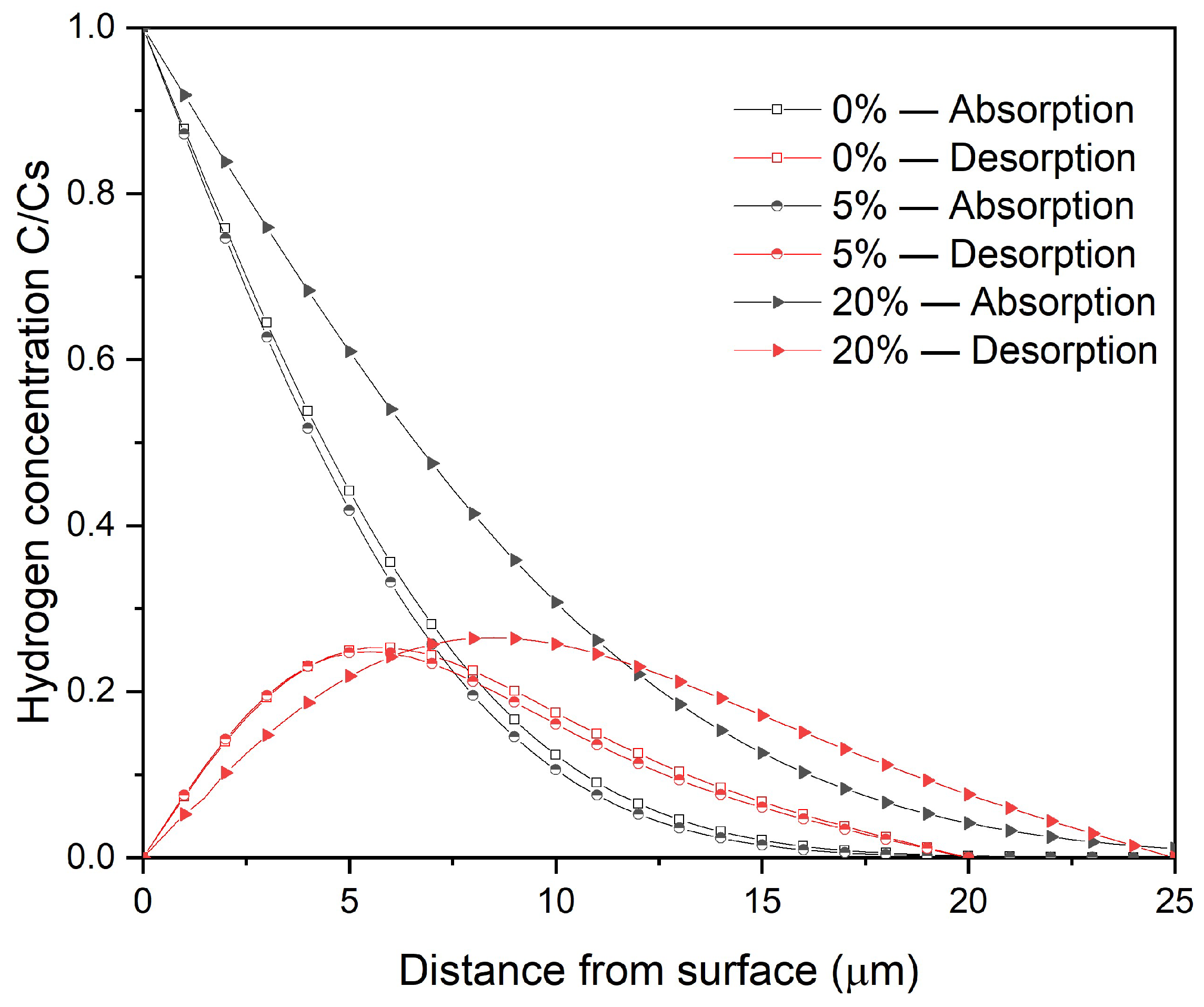
| Sample | Diffusion Coefficient (m2/s) [10] | Discharged Hydrogen after Anodic Sequence (%) | Remaining Hydrogen after Anodic Sequence (%) |
|---|---|---|---|
| Undeformed | 2.93 × 10−15 | 94.71 | 5.29 |
| 5% pre-strain | 2.65 × 10−15 | 94.56 | 5.44 |
| 20% pre-strain | 6.67 × 10−15 | 96.32 | 3.68 |
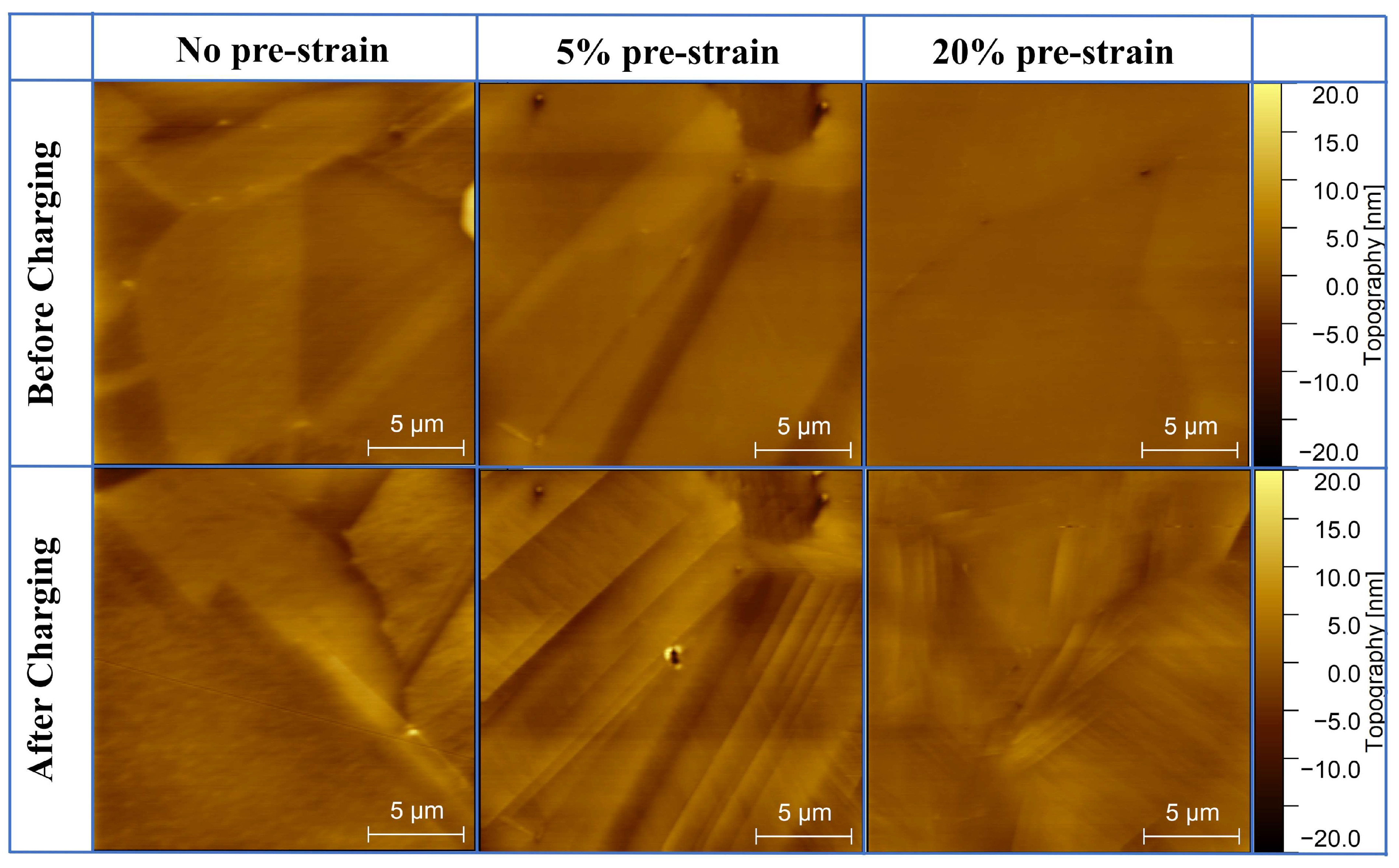
References
- Robertson, I.M.; Sofronis, P.; Nagao, A.; Martin, M.L.; Wang, S.; Gross, D.W.; Nygren, K.E. Hydrogen Embrittlement Understood. Metall. Mater. Trans. B 2015, 46, 1085–1103. [Google Scholar] [CrossRef]
- Takai, K.; Shoda, H.; Suzuki, H.; Nagumo, M. Lattice Defects Dominating Hydrogen-Related Failure of Metals. Acta Mater. 2008, 56, 5158–5167. [Google Scholar] [CrossRef]
- Lynch, S.P. Hydrogen Embrittlement (HE) Phenomena and Mechanisms. In Stress Corrosion Cracking; Elsevier: Amsterdam, The Netherlands, 2011; pp. 90–130. ISBN 9781845696733. [Google Scholar]
- Kirchheim, R. Revisiting Hydrogen Embrittlement Models and Hydrogen-Induced Homogeneous Nucleation of Dislocations. Scr. Mater. 2010, 62, 67–70. [Google Scholar] [CrossRef]
- Ghermaoui, I.M.A.; Oudriss, A.; Metsue, A.; Milet, R.; Madani, K.; Feaugas, X. Multiscale Analysis of Hydrogen-Induced Softening in f.c.c. Nickel Single Crystals Oriented for Multiple-Slips: Elastic Screening Effect. Sci. Rep. 2019, 9, 13042. [Google Scholar] [CrossRef]
- Hachet, G.; Oudriss, A.; Barnoush, A.; Milet, R.; Wan, D.; Metsue, A.; Feaugas, X. The Influence of Hydrogen on Cyclic Plasticity of <001> Oriented Nickel Single Crystal. Part I: Dislocation Organisations and Internal Stresses. Int. J. Plast. 2020, 126, 102611. [Google Scholar] [CrossRef]
- Boniszewski, T.; Smith, G.C. The Influence of Hydrogen on the Plastic Deformation Ductility, and Fracture of Nickel in Tension. Acta Metall. 1963, 11, 165–178. [Google Scholar] [CrossRef]
- Metsue, A.; Oudriss, A.; Bouhattate, J.; Feaugas, X. Contribution of the Entropy on the Thermodynamic Equilibrium of Vacancies in Nickel. J. Chem. Phys. 2014, 140, 104705. [Google Scholar] [CrossRef] [PubMed]
- Lawrence, S.K.; Yagodzinskyy, Y.; Hänninen, H.; Korhonen, E.; Tuomisto, F.; Harris, Z.D.; Somerday, B.P. Effects of Grain Size and Deformation Temperature on Hydrogen-Enhanced Vacancy Formation in Ni Alloys. Acta Mater. 2017, 128, 218–226. [Google Scholar] [CrossRef]
- Lu, X.; Díaz, A.; Ma, J.; Wang, D.; He, J.; Zhang, Z.; Johnsen, R. The Effect of Plastic Deformation on Hydrogen Diffusion in Nickel Alloy 625. Scr. Mater. 2023, 226, 115210. [Google Scholar] [CrossRef]
- Oudriss, A.; Martin, F.; Creus, J.; Bouhattate, J.; Marchetti, L.; Feaugas, X. Contributions of Polarized Dislocation Walls, Internal Stresses and Vacancies on Hydrogen Trapping Processes in Tensile Strengthening (100) Nickel Single Crystal. Acta Mater. 2023, 245, 118622. [Google Scholar] [CrossRef]
- Lu, X.; Ma, Y.; Peng, D.; Johnsen, R.; Wang, D. In situ Nanomechanical Characterization of Hydrogen Effects on Nickel-Based Alloy 725 under Different Metallurgical Conditions. J. Mater. Sci. Technol. 2022, 135, 156–169. [Google Scholar] [CrossRef]
- Wang, D.; Lu, X.; Deng, Y.; Guo, X.; Barnoush, A. Effect of Hydrogen on Nanomechanical Properties in Fe-22Mn-0.6C TWIP Steel Revealed by in-situ Electrochemical Nanoindentation. Acta Mater. 2019, 166, 618–629. [Google Scholar] [CrossRef]
- Yang, G.; Zhao, Y.; Lee, D.H.; Park, J.M.; Seok, M.Y.; Suh, J.Y.; Ramamurty, U.; Jang, J.I. Influence of Hydrogen on Incipient Plasticity in CoCrFeMnNi High-Entropy Alloy. Scr. Mater. 2019, 161, 23–27. [Google Scholar] [CrossRef]
- Hachet, G.; Oudriss, A.; Barnoush, A.; Hajilou, T.; Wang, D.; Metsue, A.; Feaugas, X. Antagonist Softening and Hardening Effects of Hydrogen Investigated Using Nanoindentation on Cyclically Pre-Strained Nickel Single Crystal. Mater. Sci. Eng. A 2021, 803, 140480. [Google Scholar] [CrossRef]
- Zhao, Y.; Lee, D.H.; Kim, W.J.; Seok, M.Y.; Kim, J.Y.; Han, H.N.; Suh, J.Y.; Ramamurty, U.; Jang, J.I. Influence of Pre-Strain on the Gaseous Hydrogen Embrittlement Resistance of a High-Entropy Alloy. Mater. Sci. Eng. A 2018, 718, 43–47. [Google Scholar] [CrossRef]
- Reddy, K.S.; Govindaraj, Y.; Neelakantan, L. Hydrogen Diffusion Kinetics in Dual-Phase (DP 980) Steel: The Role of Pre-Strain and Tensile Stress. Electrochim. Acta 2023, 439, 141727. [Google Scholar] [CrossRef]
- Hadam, U.; Zakroczymski, T. Absorption of Hydrogen in Tensile Strained Iron and High-Carbon Steel Studied by Electrochemical Permeation and Desorption Techniques. Int. J. Hydrogen Energy 2009, 34, 2449–2459. [Google Scholar] [CrossRef]
- Barnoush, A.; Vehoff, H. Recent Developments in the Study of Hydrogen Embrittlement: Hydrogen Effect on Dislocation Nucleation. Acta Mater. 2010, 58, 5274–5285. [Google Scholar] [CrossRef]
- Nibur, K.; Bahr, D.; Somerday, B. Hydrogen Effects on Dislocation Activity in Austenitic Stainless Steel. Acta Mater. 2006, 54, 2677–2684. [Google Scholar] [CrossRef]
- Oliver, W.C.; Pharr, G.M. An Improved Technique for Determining Hardness and Elastic Modulus Using Load and Displacement Sensing Indentation Experiments. J. Mater. Res. 1992, 7, 1564–1583. [Google Scholar] [CrossRef]
- Chauniyal, A.; Dehm, G.; Janisch, R. On the Role of Pre-Existing Defects in Influencing Hardness in Nanoscale Indentations—Insights from Atomistic Simulations. J. Mech. Phys. Solids 2021, 154, 104511. [Google Scholar] [CrossRef]
- Morris, J.R.; Bei, H.; Pharr, G.M.; George, E.P. Size Effects and Stochastic Behavior of Nanoindentation Pop In. Phys. Rev. Lett. 2011, 106, 165502. [Google Scholar] [CrossRef] [PubMed]
- Bei, H.; Xia, Y.Z.; Barabash, R.I.; Gao, Y.F. A Tale of Two Mechanisms: Strain-Softening versus Strain-Hardening in Single Crystals under Small Stressed Volumes. Scr. Mater. 2016, 110, 48–52. [Google Scholar] [CrossRef]
- Johnson, K. Contact Mechanics; Cambridge University Press: Cambridge, UK, 1987. [Google Scholar]
- Barnoush, A. Correlation between Dislocation Density and Nanomechanical Response during Nanoindentation. Acta Mater. 2012, 60, 1268–1277. [Google Scholar] [CrossRef]
- Song, J.; Curtin, W.A. Mechanisms of Hydrogen-Enhanced Localized Plasticity: An Atomistic Study Using α-Fe as a Model System. Acta Mater. 2014, 68, 61–69. [Google Scholar] [CrossRef]
- Ogawa, Y.; Hosoi, H.; Tsuzaki, K.; Redarce, T.; Takakuwa, O.; Matsunaga, H. Hydrogen, as an Alloying Element, Enables a Greater Strength-Ductility Balance in an Fe-Cr-Ni-Based, Stable Austenitic Stainless Steel. Acta Mater. 2020, 199, 181–192. [Google Scholar] [CrossRef]
- Gu, Y.; El-Awady, J.A. Quantifying the Effect of Hydrogen on Dislocation Dynamics: A Three-Dimensional Discrete Dislocation Dynamics Framework. J. Mech. Phys. Solids 2018, 112, 491–507. [Google Scholar] [CrossRef]
- Soundararajan, C.K.; Wang, D.; Vinogradov, A. Effect of Hydrogen on Nanomechanical Properties of Inconel 625 Studied Using In-situ Electrochemical Nanoindentation Technique. J. Alloys Compd. 2023, 948, 169742. [Google Scholar] [CrossRef]
- Nix, W.D.; Gao, H. Indentation Size Effects in Crystalline Materials: A Law for Strain Gradient Plasticity. J. Mech. Phys. Solids 1998, 46, 411–425. [Google Scholar] [CrossRef]
- Ferreira, P.J.; Robertson, I.M.; Birnbaum, H.K. Hydrogen Effects on the Interaction between Dislocations. Acta Mater. 1998, 46, 1749–1757. [Google Scholar] [CrossRef]
- Pontini, A.E.; Hermida, J.D. X-ray Diffraction Measurement of the Stacking Fault Energy Reduction Induced by Hydrogen in an AISI 304 Steel. Scr. Mater. 1997, 37, 1831–1837. [Google Scholar] [CrossRef]
- Zhang, C.; Zhi, H.; Antonov, S.; Chen, L.; Su, Y. Hydrogen-Enhanced Densified Twinning (HEDT) in a Twinning-Induced Plasticity (TWIP) Steel. Scr. Mater. 2021, 190, 108–112. [Google Scholar] [CrossRef]
- Sugiyama, Y.; Takai, K. Quantities and Distribution of Strain-Induced Vacancies and Dislocations Enhanced by Hydrogen in Iron. Acta Mater. 2021, 208, 116663. [Google Scholar] [CrossRef]
- Fukai, Y.; Shizuku, Y.; Kurokawa, Y. Superabundant Vacancy Formation in Ni–H Alloys. J. Alloys Compd. 2001, 329, 195–201. [Google Scholar] [CrossRef]
- Kirchheim, R. Solid Solution Softening and Hardening by Mobile Solute Atoms with Special Focus on Hydrogen. Scr. Mater. 2012, 67, 767–770. [Google Scholar] [CrossRef]
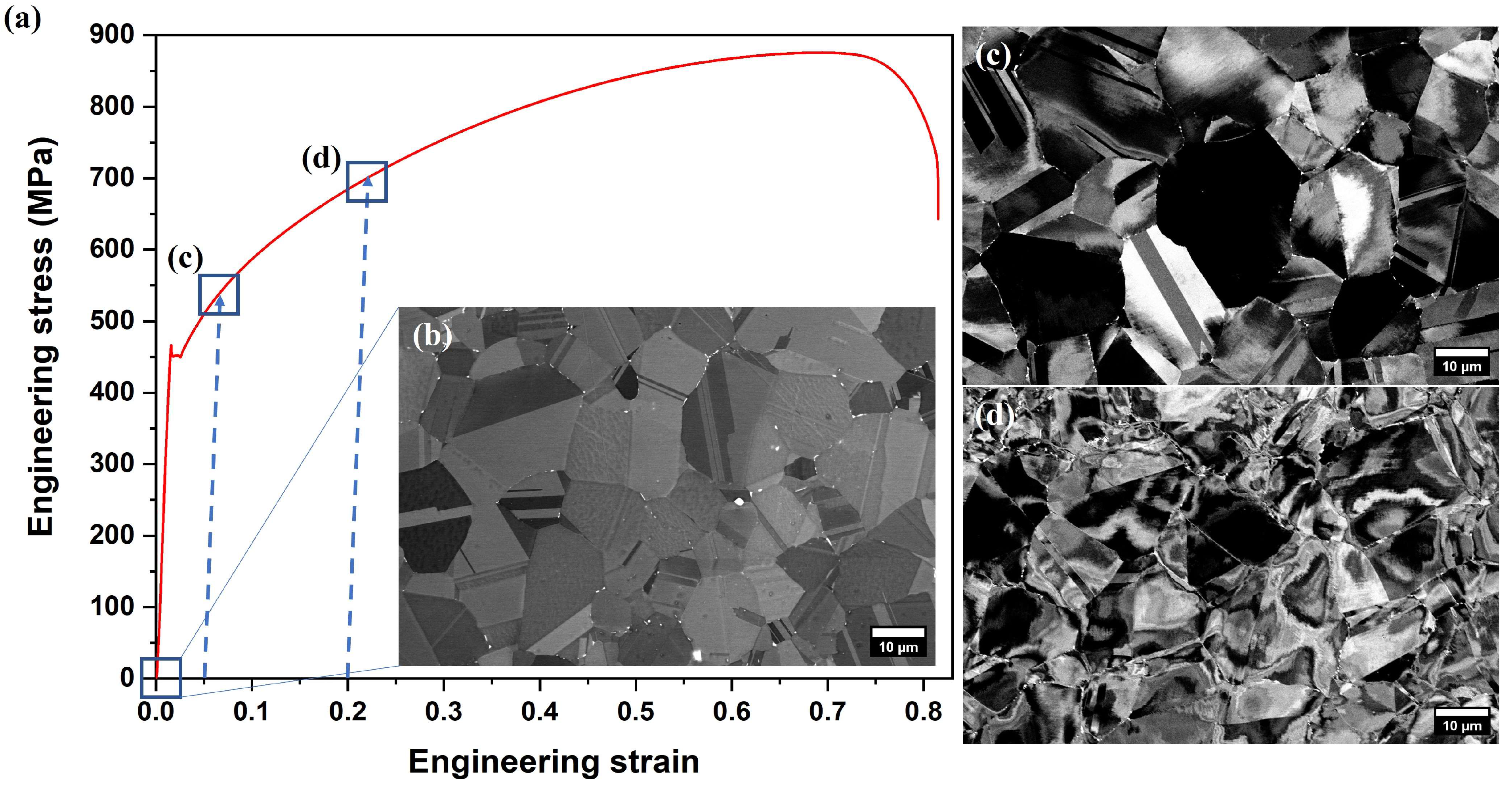


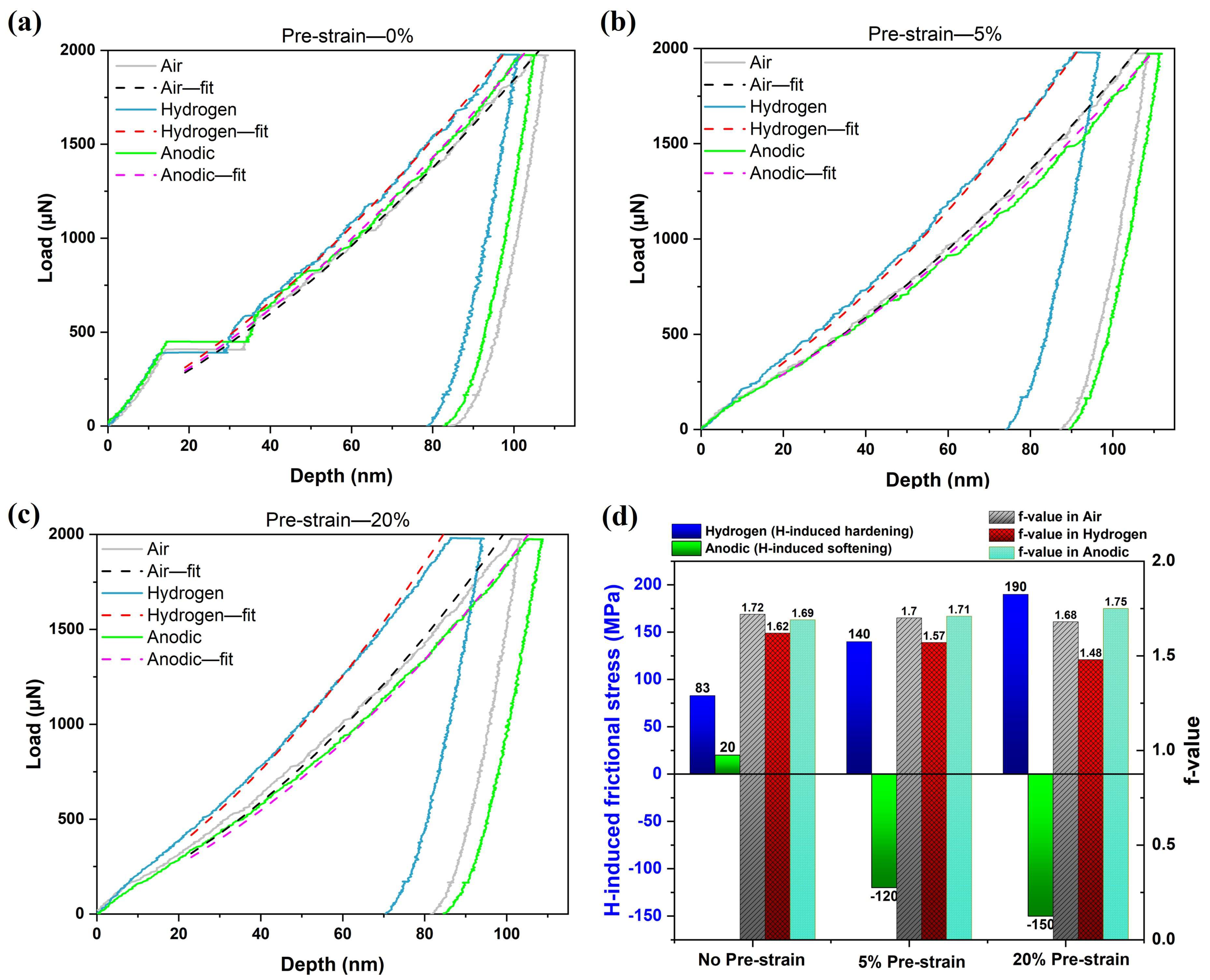
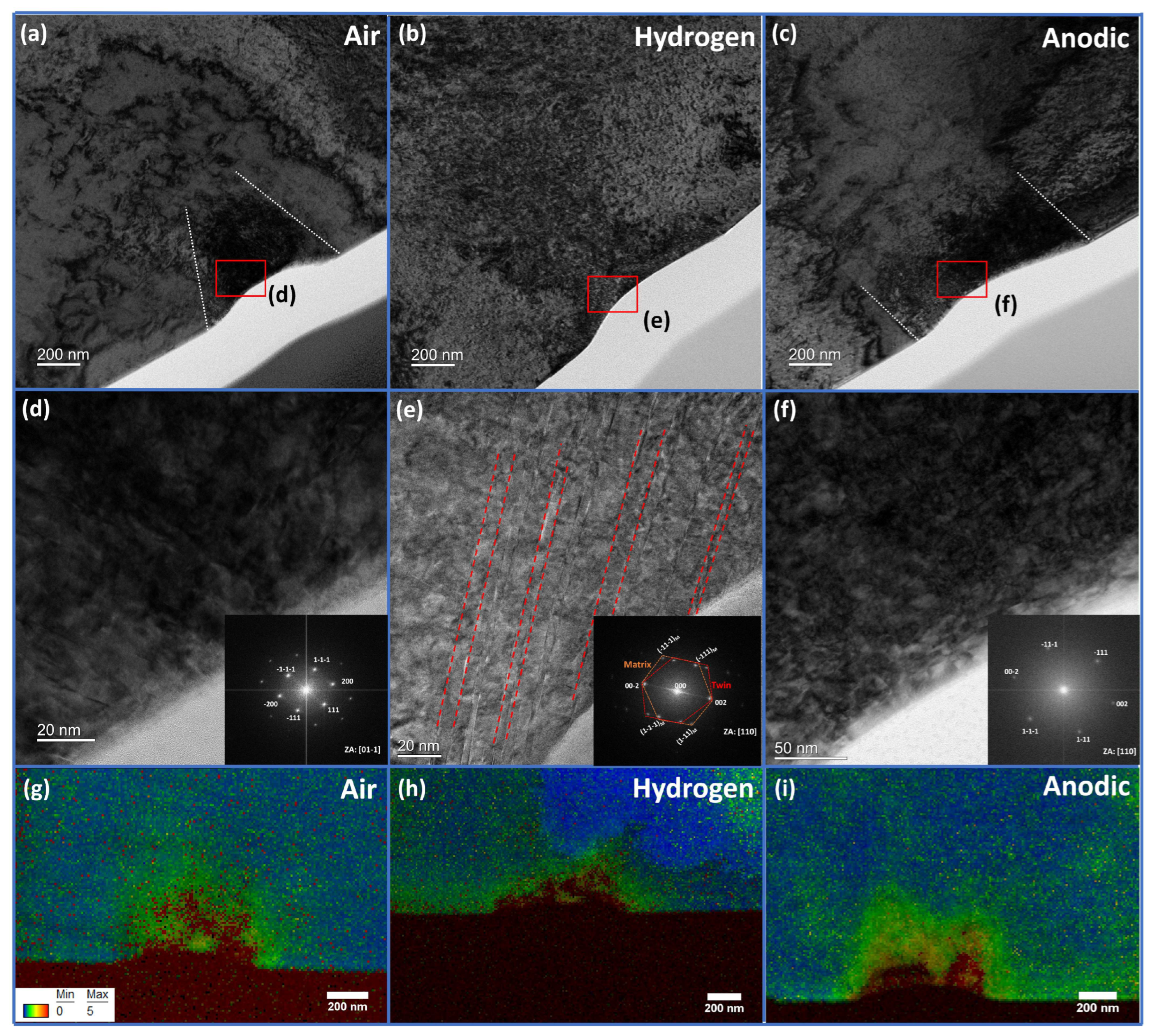
| Sample ID | Charging Condition and Duration | Total Hydrogen Content (wt. ppm) |
|---|---|---|
| 0%—H | −0.1 mA/cm2/ 2 h | 0.49 |
| 0%—Anodic | −0.1 mA/cm2/2 h (+) 0 mV/1 h | 0.15 |
| 5%—H | −0.1 mA/cm2/2 h | 0.79 |
| 5%—Anodic | −0.1 mA/cm2/2 h (+) 0 mV/1 h | 0.23 |
| 20%—H | −0.1 mA/cm2/2 h | 1.07 |
| 20%—Anodic | −0.1 mA/cm2/2 h (+) 0 mV/1 h | 0.36 |
Disclaimer/Publisher’s Note: The statements, opinions and data contained in all publications are solely those of the individual author(s) and contributor(s) and not of MDPI and/or the editor(s). MDPI and/or the editor(s) disclaim responsibility for any injury to people or property resulting from any ideas, methods, instructions or products referred to in the content. |
© 2024 by the authors. Licensee MDPI, Basel, Switzerland. This article is an open access article distributed under the terms and conditions of the Creative Commons Attribution (CC BY) license (https://creativecommons.org/licenses/by/4.0/).
Share and Cite
Soundararajan, C.K.; Lu, X.; Wang, D.; Vinogradov, A. Distinct Evidence of Hydrogen-Enhanced Defect Formation on Pre-Strained Nickel Alloy 625 during In Situ Electrochemical Nanoindentation Test. Metals 2024, 14, 161. https://doi.org/10.3390/met14020161
Soundararajan CK, Lu X, Wang D, Vinogradov A. Distinct Evidence of Hydrogen-Enhanced Defect Formation on Pre-Strained Nickel Alloy 625 during In Situ Electrochemical Nanoindentation Test. Metals. 2024; 14(2):161. https://doi.org/10.3390/met14020161
Chicago/Turabian StyleSoundararajan, Chandrahaasan K., Xu Lu, Dong Wang, and Alexei Vinogradov. 2024. "Distinct Evidence of Hydrogen-Enhanced Defect Formation on Pre-Strained Nickel Alloy 625 during In Situ Electrochemical Nanoindentation Test" Metals 14, no. 2: 161. https://doi.org/10.3390/met14020161
APA StyleSoundararajan, C. K., Lu, X., Wang, D., & Vinogradov, A. (2024). Distinct Evidence of Hydrogen-Enhanced Defect Formation on Pre-Strained Nickel Alloy 625 during In Situ Electrochemical Nanoindentation Test. Metals, 14(2), 161. https://doi.org/10.3390/met14020161






